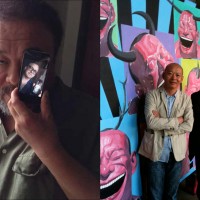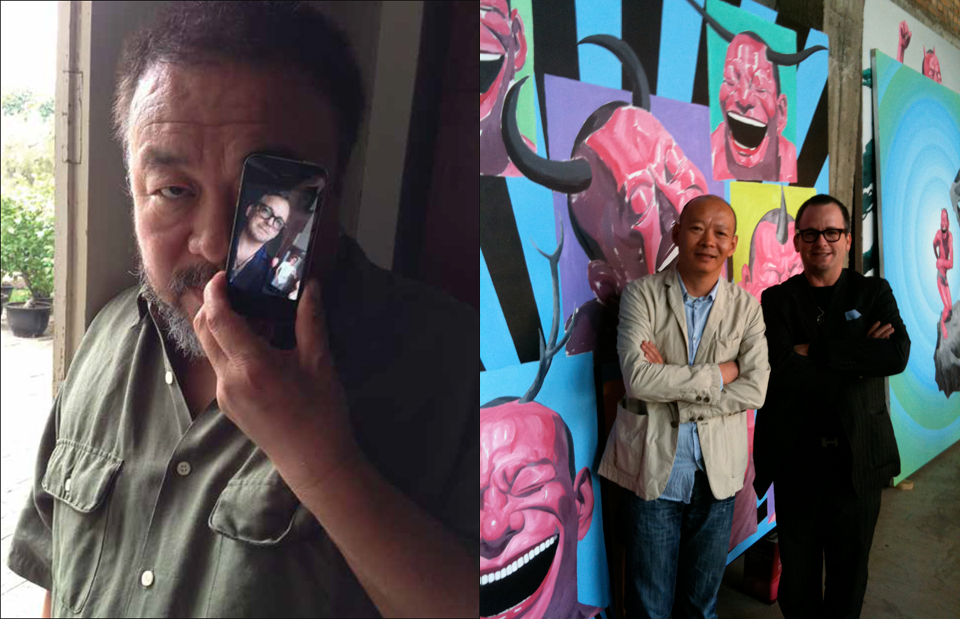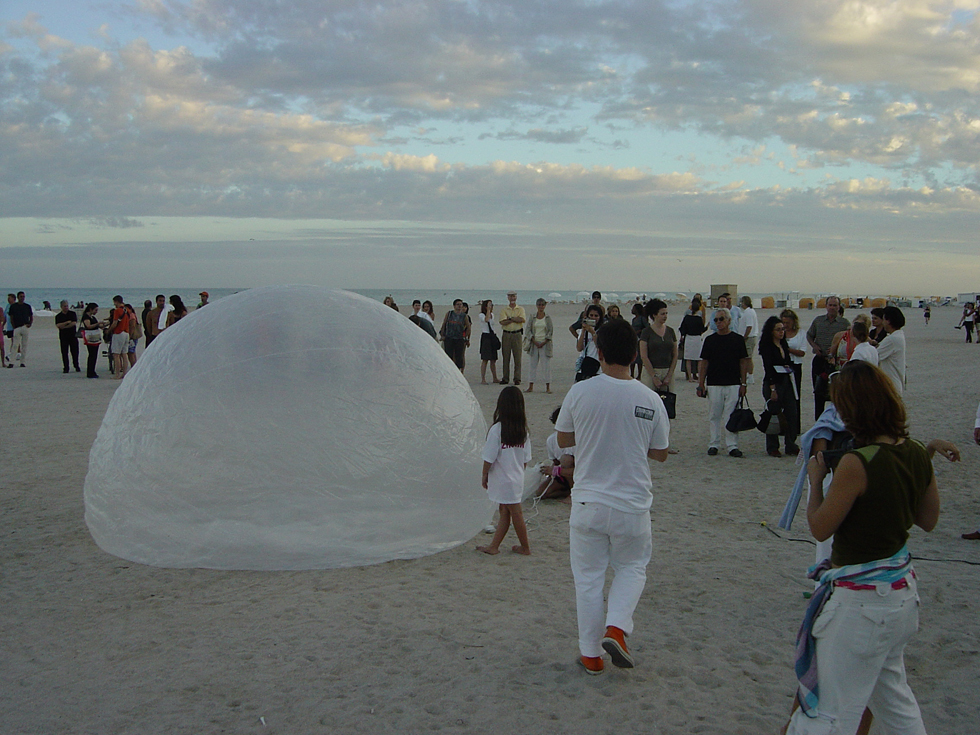Opening Miami to
Chinese Contemporary Art


Left: Ai Weiwei using Facetime with Ethan Cohen. Right: Yue Minjun (l) and Ethan Cohen (r) in Studio, 2010
In a 1988 article in Connoisseur Magazine, I was described as “an occidental orientalist” for being the first to open a New York gallery presenting a totally new phenomenon – Chinese contemporary art. I was perceived as a cultural explorer into the unknown. Chinese and contemporary — to most people the very idea oxymoronic. To them Chinese art was something frozen into strict genres — classical landscapes, folkloric apple-cheeked children, social realism. So the early part of my career I had to work extra hard to open the eyes of Americans to the power, conviction, and originality of Chinese contemporary art.
Later, in the early 2000s, I found myself pioneering in much the same way when I began to introduce Chinese art talent to Miami. But there was a difference. I wasn’t operating in a vacuum striving to educate the impervious. Everyone was coming to Miami in December to be educated and to see and buy art. By its very nature, Miami offered a much more concentrated and expansive vehicle for introducing a whole new concept. In that hothouse of rubbing shoulders with international collectors and artists, ideas could spread quickly. I matured as an art dealer during the early growth years of the satellite art fairs that accompanied Art Basel Miami Beach. I found myself being educated and challenged as a curator and businessman.
I was born into a family of Sinophiles, my father, Jerome A. Cohen, is a Professor of Chinese Law at New York University now and formerly at Harvard Law School for 25 years. He was the first Western lawyer to be accredited in the People’s Republic of China. My mother, Joan Lebold Cohen, art historian, art critic, and photographer, was the first American art historian to lecture on modern and contemporary art in China after the Cultural Revolution in 1979. My own voyage of discovery began back in 1980 when I first met the Beijing avant-garde art group “Star Stars,” featuring groundbreaking artists, many of whom became legendary figures (such as Ai Weiwei, Wang Keping, Ma Desheng, et al). The experience left a profound impression on me. I witnessed firsthand the plight of artists struggling for their freedoms. I was nineteen years old. I’d just completed my freshman year at Harvard College. My mother, Joan, invited me to join her as she interviewed the leading contemporary art group in Beijing. We went to a pre-agreed location to meet up with the “Star Stars,” but we thought we had been duped because after an hour of waiting on a street corner, no one appeared! Frustrated, we got back into our car. Just as we were leaving, a person came up to our window and gave us another address. There, at the second address, the avant-garde group was waiting. Why so much mystery? The police were looking for these young radical artists to stop them from making and showing their own art and sharing ideas with foreigners. This struck me profoundly. Difficult enough, I thought, to be an artist in New York, Miami, or London, but infinitely harder when your government is trying to repress your freedom of expression and exposure. The injustice of it astounded me and made me want to share it with the world. I became a true believer in their struggle.
In 2003, I traveled to Miami to show in the newly launched Scope Art Fair. In those days there were only four December art fairs in Miami — Art Basel, Art Miami, Scope, and NADA (New Art Dealers Alliance). Art dealers were invited to convert hotel bedrooms to galleries in the Townhouse Hotel on 18th and Collins, a stone’s throw from Art Basel Miami Beach in the Miami Beach Convention Center. Costs were low and the challenge to show contemporary art in a hotel room sounded fun and innovative. I enjoyed the puzzle of crafting ingenious ways to show art in unconventional configurations. I showed art everywhere in the suite: projections from the ceiling over the bathtub, projections onto the window shades, installations in the cabinets, on the bed, wherever space could be utilized.
That year collectors came and looked, but sales were slim. However, to a young art dealer, it was a critical moment because all the top collectors would make the effort to come look at each gallery’s display. Trying to get many of these collectors into my gallery in New York during the year was a struggle; but in Miami, they had time to relax in beautiful tropical weather, and after browsing through Art Basel, continue on to the satellite fairs. A stark contrast from today’s 28 plus fairs during the Art Basel Miami Beach marathon. In 2003, most collectors in America still did not know the importance of artists like Ai Weiwei, Xu Bing, Gu Wenda, Qiu Zhijie, Fang lijun, Yue Minjun, Zhu Ming, Zhang Dali, Zhang Huang, Chen Zhen, Gu Dexin, Lin Tianmiao, Lan Zhenghui, Qin Feng, Li Songsong, Wang Guangyi, Zhang Peili, and Yang Fudong — now internationally celebrated.
In 2004, Scope invited me to curate two special projects to raise awareness of Chinese contemporary art and to show people that vibrant and historic things could come out of a satellite art fair. I chose to bring the performance artist Zhu Ming to perform two works: the first, “Miami Bubble,” where he took off his clothing, entered a large inflated clear plastic bubble, and walked / rolled into the sea. He did it before a crowd of some 300-plus witnesses on the beach in front of the Art Basel Container installation (shipping containers used to display art). His second performance was “Phosphorus Glowing Man.” Zhu Ming covered his entire body with phosphorus paint in my shower and for 45 minutes, on the Townhouse Hotel roof penthouse suite, he shined a flashlight onto his skin to illuminate the phosphorus, and made Leonardo DaVinci’s “Vitruvian Man” poses with his body, allowing photographers to capture amazing images of him glowing in the dark.
In 2005, the Asian art market began to expand at a much faster clip. The auction market was going crazy and Sotheby’s decided to have their first stand-alone auction of Asian art in New York. It dawned on me that the moment had come to chronicle the emergence of Chinese contemporary art and Miami offered the perfect venue. Craig Robins, a well-known art collector, benefactor, and developer in Miami, agreed to co-sponsor my exhibition by giving me 15,000 square feet in the Design District. The show was titled The Chinese Art Invasion: 25 years of Innovative Chinese Art 1980 – 2005.
In 2006 and 2007, Asian art was not so prevalent in Miami, and I realized that the Miami market did not reflect the new attention that Asian art was receiving in the wider world.
It was the kind of adversity I had faced from the very start of my career. I wanted the American art world to be exposed to the original, powerful, and fresh art practice of Asian artists. I was an advisor to an Asian Art Fair in New York and I suggested to the owners that to create a successful and sustainable fair, it made more sense to have the fair in Miami than in New York, especially if they did it at the same time as Art Basel. This group did not follow my advice, but I did! I suggested the same idea to the owner of the Scope Art Fair, Alexis Hubshman and two other partners, Zhu Ceng, and Jeffrey Lawson. Art Asia was born in December 2008. It was a confusing moment for art because of the 2008 drop in the financial market, but we persevered and presented Art Asia.
Many people could not imagine that an Asian art fair would work in Miami because of the large number of other fairs already established. Art Asia was strategically placed next to the Scope Art Fair and across the street from Art Miami, which helped draw many art enthusiasts. We were pleased to say that in fact, not only could an Asian art fair exist in Miami, but that it was also extremely popular from its first days. My goal was to bring a greater consciousness of the importance of Asian art today to the art lovers who come every December to Miami. In the first year, I invited the President of the Asia Society in New York, Dr. Vishakha N. Desai, to give the keynote address at the fair. I was told that we would have a generous budget, but I remember having to personally drive to Miami International Airport to pick her up because the fair lacked sufficient funds to provide for limousine service. It was a labor of love to open people’s eyes to the talent of Asia. I was made director of Art Asia which included part ownership, but I turned it all down after its first year. I realized pretty quickly that I was happier being a curator / dealer as opposed to manager / owner of an art fair.
I knew that recognition and appreciation of Asian art would inevitably arrive, though I didn’t know the time frame. It seemed predictable that in the near future, once the other twenty eight-plus satellite fairs and all the galleries that exhibit at Art Basel integrated Asian art into their programs, the concept of a stand-alone Asian art fair would not be necessary. Research into the Asian art market in the early 2000s found that there were under twenty Asian artists showing in New York galleries. By 2012, there were well over 200. Asian art had come of age and was being fully exhibited in Art Basel, Art Miami, Nada, Pulse, Context, Aqua, Scope, and many other fairs. As a result, Art Asia folded its tent in 2013.
Today, my gallery focus is to search for global talent — in China, Africa, or New York City. I continue my specialty in Chinese contemporary art and have chosen to work with artists like Li Daiyun, a fabulous oil painter from Beijng, or Lan Zhenghui, one of the most exciting ink painters in the world, who is also from Beijing. I have expanded my interest by showing the most dynamic young African painter from Ivory Coast, Aboudia, who has captivated the eye of many top collectors, including Charles Saatchi. In December 2015, I will showcase global art that is original, honest, well-crafted, and fresh at Art Miami and the Context Art Fair. ♦



